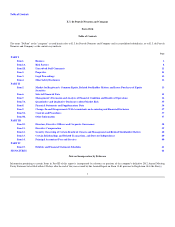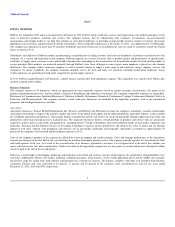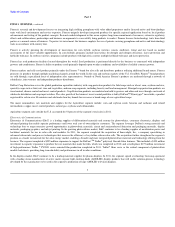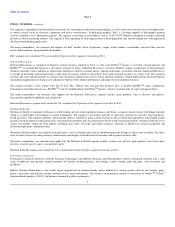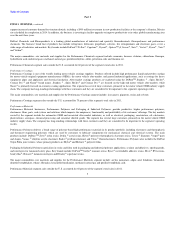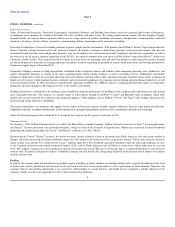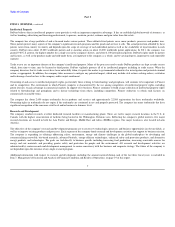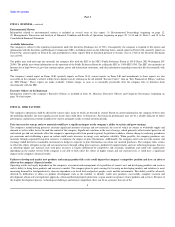DuPont 2011 Annual Report Download - page 13
Download and view the complete annual report
Please find page 13 of the 2011 DuPont annual report below. You can navigate through the pages in the report by either clicking on the pages listed below, or by using the keyword search tool below to find specific information within the annual report.
Table of Contents
Part I
ITEM 1A. RISK FACTORS, continued
competitive, adversely affecting sales.
Changes in government policies and laws could adversely affect the company's financial results.
Sales outside the U.S. constitute approximately 65 percent of the company's 2011 revenue. The company anticipates that international sales will continue to
represent a substantial portion of its total sales and that continued growth and profitability will require further international expansion, particularly in
developing markets. Sales from developing markets represent 34 percent of the company's revenue in 2011 and the company's growth plans include focusing
on expanding its presence in developing markets. The company's financial results could be affected by changes in trade, monetary and fiscal policies, laws
and regulations, or other activities of U.S. and non-U.S. governments, agencies and similar organizations. These conditions include, but are not limited to,
changes in a country's or region's economic or political conditions, trade regulations affecting production, pricing and marketing of products, local labor
conditions and regulations, reduced protection of intellectual property rights in some countries, changes in the regulatory or legal environment, restrictions on
currency exchange activities, burdensome taxes and tariffs and other trade barriers. International risks and uncertainties, including changing social and
economic conditions as well as terrorism, political hostilities and war, could lead to reduced sales and profitability.
Economic factors, including inflation, deflation and fluctuations in currency exchange rates, interest rates and commodity prices could affect the
company's financial results.
The company is exposed to fluctuations in currency exchange rates, interest rates and commodity prices. Because the company has significant international
operations, there are a large number of currency transactions that result from international sales, purchases, investments and borrowings. The company
actively manages currency exposures that are associated with net monetary asset positions, committed currency purchases and sales, foreign currency-
denominated revenues and other assets and liabilities created in the normal course of business. Failure to successfully manage these risks could have an
adverse impact on the company's financial position, results of operations and cash flows.
Conditions in the global economy and global capital markets may adversely affect the company's results of operations, financial condition, and cash
flows.
The company's business and operating results may in the future be adversely affected by global economic conditions, including instability in credit markets,
declining consumer and business confidence, fluctuating commodity prices, volatile exchange rates, and other challenges that could affect the global
economy. The company's customers may experience deterioration of their businesses, cash flow shortages, and difficulty obtaining financing. As a result,
existing or potential customers may delay or cancel plans to purchase products and may not be able to fulfill their obligations in a timely fashion. Further,
suppliers could experience similar conditions, which could impact their ability to fulfill their obligations to the company. Adversity within capital markets
may impact future return on pension assets, thus resulting in greater future pension costs that impact the company's results. Future weakness in the global
economy could adversely affect the company's results of operations, financial condition and cash flows in future periods.
The company's results of operations and financial condition could be seriously impacted by business disruptions and security threats.
Business disruptions, including supply disruptions, increasing costs for energy, temporary plant and/or power outages and information technology system and
network disruptions, could seriously harm the company's operations as well as the operations of its customers and suppliers. Like many other multinational
organizations, the company faces security threats to its facilities, data and information technology infrastructure. Although it is impossible to predict the
occurrences or consequences of business disruptions or security threats, they could result in reduced demand for the company's products, make it difficult or
impossible for the company to deliver products to its customers or to receive raw materials from suppliers, and create delays and inefficiencies in the supply
chain. The company actively manages the risks within its control that could lead to business disruptions or security breaches in order to mitigate any potential
impact from business disruptions regardless of cause including acts of sabotage, terrorism or war, weather events and natural disasters. Despite these efforts,
the impact from business disruptions and security breaches could significantly increase the cost of doing business or otherwise adversely impact the
company's financial performance.
Inability to protect and enforce the company's intellectual property rights could adversely affect the company's financial results.
Intellectual property rights, including patents, plant variety protection, trade secrets, confidential information, trademarks, tradenames and other forms of trade
dress, are important to the company's business. The company endeavors to protect its intellectual property rights in jurisdictions in which its products are
produced or used and in jurisdictions into which its products are imported. However, the company may be unable to obtain protection for its intellectual
property in key jurisdictions. The company has designed and implemented internal controls to restrict access to and distribution of its intellectual property.
Despite these
10



